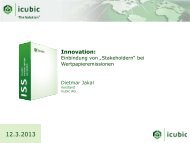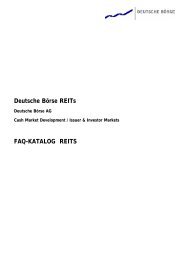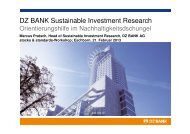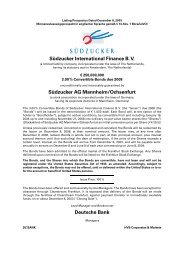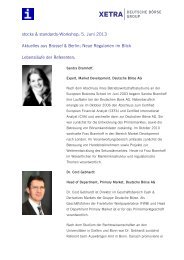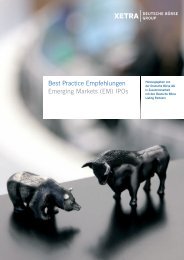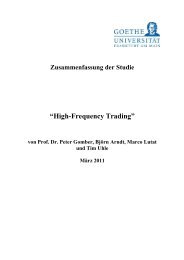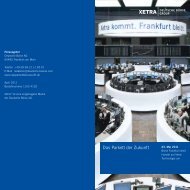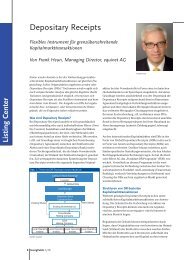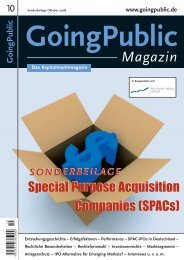High-frequency trading – a discussion of relevant issues - Xetra
High-frequency trading – a discussion of relevant issues - Xetra
High-frequency trading – a discussion of relevant issues - Xetra
- No tags were found...
Create successful ePaper yourself
Turn your PDF publications into a flip-book with our unique Google optimized e-Paper software.
<strong>High</strong>-<strong>frequency</strong> <strong>trading</strong> <strong>–</strong> a <strong>discussion</strong> <strong>of</strong> <strong>relevant</strong> <strong>issues</strong> May 2013Literature review (II/III)Author(s) / Title Dataset FindingsCredit Suisse“Sizing Up US Equity Microstructure”, April 2010Hasbrouck, Saar"Low-Latency Trading“, May 2011Hendershott, Riordan“Algorithmic Trading and Information”, August2009Chaboud, Hjalmarsson, Vega and Chiquoine“Rise <strong>of</strong> the Machines: Algorithmic Trading in theForeign Exchange Market”, October 2009RGM Advisors(Castura, Litzenberger, Gorelick, Dwivedi)“Market Efficiency and Microstructure Evolution inUS Equity Markets: A <strong>High</strong> FrequencyPerspective”, October 2010X. Frank Zhang“The Effect <strong>of</strong> <strong>High</strong>-Frequency Trading on StockVolatility and Price Discovery” November 2010Boehmer, Fong, Wu (2012)“International evidence on algorithmic <strong>trading</strong>”U.S. equities, 2003 - 2010U.S. equities, full NASDAQ order book June2007 and October 2008Automated vs. other trades. Deutsche Börseequities, January 2008Automated vs. other trades.EBS forex market, 2006-2007U.S. equities, 2006 - 2010Firms from the Center for research in securityprices (CRSP) and the Thomson ReutersInstitutional Holdings databases during 1985<strong>–</strong>2009.Large sample from 2001 <strong>–</strong> 2009 thatincorporates 39 exchanges and an average <strong>of</strong>12,800 different common stocksBid -ask spreads have narrowed, available liquidity hasincreased and short-term volatility (normalized by longerterm volatility) has declinedLow latency automated <strong>trading</strong> was associated withlower quoted and effective spreads, lower volatility andgreater liquidityAutomated trades made prices more efficient and did notcontribute to higher volatilityAutomated trades increased liquidity and may havelowered volatilityBid-ask spreads have narrowed, available liquidity hasincreased and price efficiency has improvedThis study examines the effect <strong>of</strong> high-<strong>frequency</strong> <strong>trading</strong>on stock price volatility and price discoveryWe find that greater AT intensity is, on average,associated with more liquidity, whether measured at thetransaction level or at the daily level, faster pricediscovery, and greater volatility56




